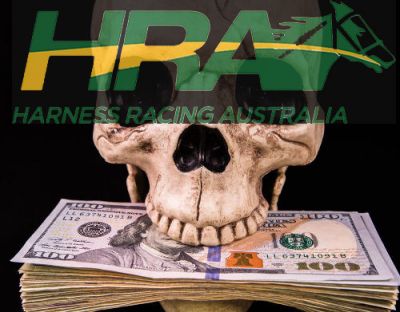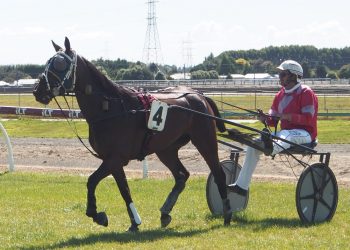 The new ‘Stallion Levy’ proposed by Harness Racing Australia is a move that has created more questions than answers as Australasia’s biggest breeders know it will have a negative ripple effect on the industry at all levels.
The new ‘Stallion Levy’ proposed by Harness Racing Australia is a move that has created more questions than answers as Australasia’s biggest breeders know it will have a negative ripple effect on the industry at all levels.
What is wrong with Harness Racing Australia and Andrew Kelly?
With Andrew Kelly producing FAKE NEWS with ridiculous numbers today of $18 million spent on “International Sires” it is hard to understand how HRA can justify his salary. With no experience and no investment in the Stallion business he is out of control. He has been in this position for 12 years and far too long!
Andrew Kelly is not the only person responsible for this proposed TAX though. Below this letter, we have listed all State members that have been a part of this TAX proposal.
This is what the majority of breeders have to say today about this unbelievable TAX that HRA is trying to get in place;
Dear Mr. Kelly & the HRA Executive
With regards to your recent announcement of a proposed 15% levy on all shuttle and frozen semen non-resident stallions, we would like to formally express our opposition to this Proposal. It is extremely disappointing that there was no industry consultation or discussion in advance of this Proposal. Stud farms, stallion owners and breeders’ organisations were not notified of this Proposal prior to the posting of a general press release on the HRA website. This press release creates far more questions than answers.
Based on the breeding data available on HarnessWeb as of April 19th, there were 5,118 total mares bred in Australia to 166 registered stallions in the 2020/21 season. Pacing stallions served a total of 4,331 Australian mares with Australian domiciled stallions serving the majority of mares – 2,662 (61%). The remaining 39% of pacing mares bred (1,669) were served with semen from shuttle and frozen semen stallions. Australian-based shuttle stallions served 700 pacing mares, NZ-based shuttle stallions served 531 Australian pacing mares and North American frozen semen was used to serve 438 pacing mares.
A total of 787 trotting mares were bred in Australia. Australian domiciled stallions served 292 trotting mares (37%). The remaining 63% of trotting mares (495) were served with semen from U.S. shuttle stallions, frozen semen from U.S. and European stallions and NZ domiciled stallions. Australian-based shuttle stallions served 62 trotting mares, NZ-based shuttle stallions covered 29 trotting mares, NZ domiciled stallions 109 mares and non-resident frozen semen was used to serve 295 trotting mares.
Pacing and trotting stallions who permanently reside in Australia accounted for 58% of all mares bred last season. It should be noted that 114 Australian domiciled stallions will not be assessed this levy and therefore will not be contributing any funds to HRA’s 15% Proposal.
Contrary to the opinions of a few self-interested parties who have created a huge misconception within the industry, there is far less money being paid to North American breeding syndicates for the use of their stallions than rumored. In addition, a large percentage of breeding rights for several of the most prominent shuttle stallions are owned by Australian/New Zealand studs or investors with the bulk of collected service fees remaining in Australasia as a return on investment. Also, many stallions are under long-term lease agreements contracted when a 15% levy was not included in the configuration of expenses.
Breeding farms have been relied on to help support the industry by offering discounts as high as 25% to breeders to assist them with rising costs and to provide complimentary breeding’s to clubs and breeders organisations throughout the country as well as various sponsorships within the industry. Now it is proposed that stud owners fund prize money increases to the Inter Dominion, Derbys and Oaks for benefit of a select few.
We are not in agreement that breeding should be funding racing.
Most of the studs who stand shuttle or offer frozen semen stallions have made significant contributions to the Australian agricultural and general economy. We have made substantial investments in property, buildings, equipment and livestock, we employ staff, purchase hay, feed and other farm supplies as well as support many local businesses (printers, office supplies, petrol, etc.).
If this levy were to be adopted by HRA, there would most definitely be a ripple effect felt throughout the entire industry. HRA is attempting to change the way studs conduct their business which we feel would result in a dramatic change to the established culture of breeding. Breeders should be afforded the option of selecting the best stallions available for their mares without being penalized by a 15% levy. Below are just some of the major impacts we believe this 15% levy would have on Australian breeding.
- It has been a long-standing practice within the industry for studs to offer breeders a discount on the advertised service fee – whether it be for early payment, bookings for multiple mares or farm loyalty discounts. Over the last 25 years, very few breeders, if any, have ever paid the full advertised service fee. This proposed 15% levy on the advertised service fee will certainly see the elimination or reduction of service fee discounts for both shuttle and frozen semen stallions. This levy is extremely discriminatory as it provides Australian domiciled stallions a 15% price advantage as they are not subject to this levy.
- Many studs offer clients the opportunity to pay the service fee on a live foal basis. HRA has stated the proposed 15% levy will be imposed following a 42-day positive pregnancy test which may lead to the elimination of these pay on live foal options.
- With regards to the proposed 15% levy being invoiced on a 42-day positive pregnancy test, does this levy carry a live foal guarantee or a refund to the stud farm if the mare fails to deliver a live foal and when would this be repaid? Is the levy applicable to free returns? Complimentary breeding’s? Donations?
- Ultimately it appears that studs will have little or no choice but to pass this proposed levy on to breeders. Studs cannot be expected to absorb this additional cost on top of an already expense laden business. As breeders’ costs rise due to this levy, breeding numbers, live foals and race starters will undoubtedly decrease.
- This levy is an HRA attempt to push breeders towards supporting Australian/Colonial stallions who are not subjected to this levy. The most popular and successful commercial stallions available to breeders in Australia are shuttle or frozen semen stallions.
- Commercial breeders are less likely to experience the same returns at the yearling sales that they currently enjoy if they are forced to breed to “Colonial” stallions due to this levy.
- The considerable number of horses exported overseas by Australian owners will also be affected as Colonial-sired horses will not be as recognizable and may not be in great demand by mainstream North American or European buyers.
- Stallion choices in the future will be limited as fewer shuttle/frozen semen stallions will be available due to this proposed levy. This levy, added to the mounting costs of shuttling to the southern hemisphere, will question the economical feasibility of bringing the best-bred and performed stallions to Australasia.
- Faced with both 10% GST and this 15% levy, most international stallion owners will be discouraged from considering Australia in the future.
- If fewer mares are bred to shuttle/frozen semen stallions due to this levy, the Australasian gene pool will be negatively affected in the future.
- This 15% levy will negatively impact industry sponsorships. Studs have played a critical role in race and club sponsorships over the years, but this levy will certainly affect monies available for these sponsorships. If studs are being asked to fund racing prize money as suggested in your Proposal, how can they be asked to continue to sponsor tracks, clubs and smaller industry events as well? As an example, International Racehorse Transport has stepped up its sponsorship of the Standardbred industry in the last several years, but if fewer stallions are flying back and forth from North America or Europe, how can IRT be expected to support an industry that no longer supports their business model?
We would like to request a meeting with the HRA Executive to further discuss our concerns regarding this proposed 15% levy. It is evident that HRA has not considered this Proposal from the point of view of the Studs. We would welcome the opportunity to educate the Executive on the realities of the breeding industry and assist in seeking alternative proposals to benefit the ENTIRE Standardbred community.
Faithfully yours,
Pat Driscoll, Haras des Trotteurs/Yabby Dam Farm
Alan Galloway, Alabar Farms
Mark Hughes, Woodlands Stud (NZ) Ltd
David James, Empire Stallions Corp
Dr. Kath McIntosh, Northern Rivers Equine Vet Clinic
Kody Charles, KTC Bloodstock
Belinda McCarthy, Cobbity Equine Farm
Ged Mooar, Nevele R Stud
Peter O’Rourke, Stallions Australasia
Anthony Perkins, Trump Bloodstock
Darren Reay, Medowie Lodge
…………………………………………….
Here are the people that are complicit in proposing this TAX.
One of the main promoters of this TAX is one of those members Bob Fowler who has a vested interest in Colonial stallions.
Feel free to lobby these ill informed officials below.
| HRA Office Bearers, National Body, Corporate & Service Providers | |||||||||||||||||||||||||||||||||||||||||||||||||||||||||||||||||||||||||
Office Bearers for 2020/2021 Effective Date of Implementation: 30 October 2020
|
|||||||||||||||||||||||||||||||||||||||||||||||||||||||||||||||||||||||||
HRA National Body
|
|||||||||||||||||||||||||||||||||||||||||||||||||||||||||||||||||||||||||

 USA
USA Canada
Canada Australia
Australia New Zealand
New Zealand Europe
Europe UK / IRE
UK / IRE











